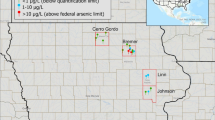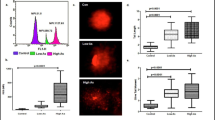Abstract
Objectives
The respiratory effects of chronic low-level arsenic exposure from groundwater have been investigated in West Bengal, India.
Methods
The participants (834 non-smoking adult males) were subdivided in two groups: an arsenic-exposed group (n = 446, mean age 35.3 years) drinking arsenic-contaminated groundwater (11–50 μg/L) and a control group of 388 age-matched men drinking water containing <10 μg/L of arsenic. Arsenic in water samples was measured by atomic absorption spectroscopy. The prevalence of respiratory symptoms was documented by structured, validated questionnaire. Pulmonary function test (PFT) was assessed by portable spirometer.
Results
Compared with control, the arsenic-exposed subjects had higher prevalence of upper and lower respiratory symptoms, dyspnea, asthma, eye irritation and headache. Besides, 20.6 % of arsenic-exposed subjects had lung function deficits (predominantly restrictive and combined types) compared with 13.6 % of control (p < 0.05). A positive association was observed between arsenic concentration in drinking water and the prevalence of respiratory symptoms, while a negative association existed between arsenic level and spirometric parameters.
Conclusions
The findings suggest that even low-level arsenic exposure has deleterious respiratory effects.



Similar content being viewed by others
References
American Thoracic Society (1995) Standardization of spirometry 1994 update. Am J Resp Crit Care Med 152:1107–1136
Behari JR, Prakash R (2006) Determination of total arsenic content in water by atomic absorption spectroscopy (AAS) using vapour generation assembly (VGA). Chemosphere 63:17–21
Bhattacharjee P, Chatterjee D, Singh KK, Giri AK (2013) Systems biology approaches to evaluate arsenic toxicity and carcinogenicity: an overview. Int J Hyg Env Health 216:574–586
Borgono JM, Vicent P, Venturino H, Infante A (1977) Arsenic in the drinking water of the city of Antofagasta: epidemiological and clinical study before and after the installation of a treatment plant. Environ Health Perspect 19:103–105
Bureau of Indian Standards [BIS] (2009) Draft Indian standard. Drinking water specification (second revision of IS 10500). Doc: FAD 25(2047) C. Last date for comments: 24/12/2009. http://bis.org.in/sf/fad/FAD25(2047)C.pdf
Caussy D (2005) A field guide for detection, management, and surveillance of arsenicosis cases. World Health Organization, Regional Office of South-East Asia, New Delhi
Chakraborti D, Das B, Murrill M (2011) Examining India’s groundwater quality management. Environ Sci Technol 45:27–33
Chiou HY, Hsueh YM, Liaw KF, Horng SF, Chiang MH, Pu YS, Lin JS, Huang CH, Chen CJ (1995) Incidence of internal cancers and ingested inorganic arsenic: a seven-year follow-up study in Taiwan. Cancer Res 55:1296–1300
Cotes JE (1987) Medical Research Council Questionnaire on Respiratory Symptoms (1986). Lancet 2:1028
De BK, Majumdar D, Sen S, Guru S, Kundu S (2004) Pulmonary involvement in chronic arsenic poisoning from drinking contaminated ground-water. J Assoc Phys India 52:395–400
Eltayara L, Becklake MR, Volta CA, Milic-Emili J (1996) Relationship between chronic dyspnea and expiratory flow limitation in patients with chronic obstructive pulmonary disease. Am J Resp Crit Care Med 154:1726–1734
Ferris BG (1978) Epidemiology standardization project (American Thoracic Society). Am Rev Resp Dis 118:1–120
Fullerton DG, Suseno A, Semple S, Kalambo F, Malamba R, White S, Jack S, Calverley PM, Gordon SB (2011) Wood smoke exposure, poverty and impaired lung function in Malawian adults. Int J Tuberc Lung Dis 15:391–398
Gerhardsson L, Brune D, Nordberg GF, Wester PO (1988) Multielemental assay of tissues of deceased smelter workers and controls. Sci Total Environ 74:97–110
Global Lung Function Initiative [GLI] (2012). http://www.lungfunction.org. Accessed 21 Nov 2013
Hotta N (1989) Clinical aspects of chronic arsenic exposure poisoning due to environmental and occupational pollution in and around a small refining spot. Jpn J Const Med 53:49–70
International Agency for Research on Cancer [IARC] (1987) Monographs on the evaluation of carcinogenic risks to humans, Supplement 7: overall evaluations of carcinogenicity: an updating of IARC monographs, vol 1–42. http://monographs.iarc.fr/ENG/Monographs/suppl17-19. Accessed Nov 15 2013
James WP, Mascie-Taylor GC, Norgan NG, Bistrian BR, Shetty PS, Ferro-Luzzi A (1994) The value of arm circumference measurements in assessing chronic energy deficiency in third world adults. Eur J Clin Nutr 48:883–894
Lantz RC, Hays AM (2006) Role of oxidative stress in arsenic-induced toxicity. Drug Metabol Rev 38:791–804
Liard R, Neukirch F (2000) Questionnaires: a major instrument for respiratory epidemiology. Eur Resp Monogr 15:154–166
Lopez AD (2013) Reducing risks to health: what can we learn from the Global Burden of Disease 2010 Study? Int J Public Health 58:645–646
Mazumder DN, Haque R, Ghosh N, De BK, Santra A, Chakraborti D, Smith AH (2000) Arsenic in drinking water and the prevalence of respiratory effects in West Bengal, India. Int J Epidemiol 29:1047–1052
Mazumder DN, Steinmus C, Bhattacharaya P, von Ehrenstein OS, Balmes J, Sil A, Ghosh N, Hira-Smith M, Haque R, Purushothamam R, Lahiri S, Das S, Smith AH (2005) Bronchiectasis in persons with skin lesions resulting from arsenic in drinking water. Epidemiology 16:760–765
Miller WF, Wu N, Johnson RL Jr (1956) Convenient method of evaluating pulmonary ventilatory function with a single breath test. Anesthesiology 17:480–493
National Research Council (NRC) (1999) Report: arsenic in the drinking water. National Academy Press, Washington, DC
Nemery B (1990) Metal toxicity and the respiratory tract. Eur Resp J 3:202–219
Pakhale S, Bshouty Z, Marras TK (2009) Comparison of percent predicted and percentile values for pulmonary function test interpretation. Can Resp J 16:189–193
Parvez F, Chen Y, Brandt-Rauf PW, Bernard A, Dumont X, Slavkovich V, Argos M, D’Armiento J, Foronjy R, Hasan MR, Eunus HE, Graziano JH, Ahsan H (2008) Nonmalignant respiratory effects of chronic arsenic exposure from drinking water among never-smokers in Bangladesh. Environ Health Perspect 116:190–195
Peiris-John RJ, Ruberu DK, Wickremasinghe AR, van-der-Hoek W (2005) Low-level exposure to organophosphate pesticides leads to restrictive lung dysfunction. Resp Med 99:1319–1324
Pope CA III, Dockery DW (1999) Epidemiology of particle effects. In: Holgate ST, Samet JM, Koren HS, Maynard RL (eds) Air pollution and health. Academic Press, San Diego, pp 673–705
Saady JJ, Blanke RV, Poklis A (1989) Estimation of the body burden of arsenic in a child fatally poisoned by arsenite weedkiller. J Anal Toxicol 13:310–312
Smith AH, Goycolea M, Haque R, Biggs ML (1998) Marked increase in bladder and lung cancer mortality in a region of northern Chile due to arsenic in drinking water. Am J Epidemiol 147:660–669
Smith AH, Lopiper PA, Bates MN, Steinmaus CM (2002) Arsenic epidemiology and drinking water standards. Science 296:2145–2146
Smith AH, Marshall G, Yuan Y, Ferreccio C, Liaw J, von Ehrenstein O, Steinmaus C, Bates MN, Selvin S (2006) Increased mortality from lung cancer and bronchiectasis in young adults after exposure to arsenic in utero and in early childhood. Environ Health Perspect 114:1293–1296
US Environmental Protection Agency [EPA] (2001) Technical fact sheet: proposed rule for arsenic in drinking water. US Environmental Protection Agency, Washington, DC, USA
von Ehrenstein OS, Mazumder DN, Yuan Y, Samanta S et al (2005) Decrements in lung function related to arsenic in drinking water in West Bengal, India. Am J Epidemiol 162:533–541
World Health Organization [WHO] (1993) Guidelines for drinking-water quality. WHO, Geneva
Zaldivar R, Ghai GL (1980) Clinical epidemiological studies on endemic chronic arsenic poisoning in children and adults, including observations on children with high- and low-intake of dietary arsenic. Zentralbl Bakteriol [B] 170:409–421
Acknowledgments
The authors would like to acknowledge the funding agency, Central Pollution Control Board, Govt. of India, for providing the grant support for the project. The authors would also like to thank Prof. (Dr.) Jaydip Biswas, Director, Chittaranjan National Cancer Institute for providing the infrastructural facilities.
Conflict of interest
None declared.
Ethical standards
The experiments comply with the current laws of India where they were performed. The work was approved by Institutional Ethics Committee, Chittaranjan National Cancer Institute, Kolkata.
Author information
Authors and Affiliations
Corresponding author
Additional information
This article was submitted to the 2013 call for papers "Environment and Health Reviews".
Rights and permissions
About this article
Cite this article
Das, D., Bindhani, B., Mukherjee, B. et al. Chronic low-level arsenic exposure reduces lung function in male population without skin lesions. Int J Public Health 59, 655–663 (2014). https://doi.org/10.1007/s00038-014-0567-5
Received:
Revised:
Accepted:
Published:
Issue Date:
DOI: https://doi.org/10.1007/s00038-014-0567-5




